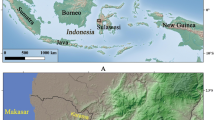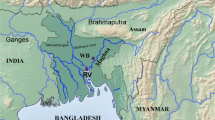Abstract
Japanese rice cultivation in paddy fields has 2,400∼3,000 years of history. Most of modern Japanese rice varieties are classified as Temperate-japonica (Tm-J). Few landraces are recognized as Tropical-japonica (Tr-J) only in southwestern Japan. However, ancient DNA studies and phytolith analysis suggest that Tr-J strains were more popular in the past than now. Maekawa is a complex archaeological site composed of paddies dated from the Yayoi (2,100 years BP) to the Heian (1,100 years BP) periods. Phytolith analysis indicates that intensive rice cultivation was practiced in both periods, but there was no cultivation in the intervening period. Morphological features of bulliform phytoliths suggest that Tr-J was cultivated during both periods. Locally, rice cultivation during the Heian period was brought to a close by a flood event, in which immature rice plants were pulled down and buried in silt to be preserved in a quasi-carbonized/ waterlogged state. Ancient DNA (aDNA) analysis of the carbonized plant culm from Heian Maekawa recovered chloroplast DNA sequences of the 6C7A plastid subtype, which is common to both Tr-J and Tm-J, whereas two plastid subtypes, such as 6C7A and also 7C6A, were found in aDNA of carbonized grains from the Tareyanagi site of the Yayoi period. The latter plastid subtype was specific only to Tr-J. In order to better characterize the past rice populations, modern landraces collected in the local area were classified with morphophysiological traits. Some of the landraces were found to carry several traits of Tr-J, including bulliform phytolith types, but mixed with Tm-J traits. Based on the discontinuous distribution of rice phytoliths between the Yayoi and the Heian period, the early introduction of rice cultivation may have been discontinuous and locally reintroduced after a ∼1,000-year hiatus, but with a genetically different rice population. Such populations were composed from Tr-J like strains as shown by landraces but with reduced diversity in plastid types. Through such changes, since the Yayoi era, Tr-J was largely replaced by Tm-J, although ancient Tr-J continued to participate in the genetic makeup of later rice populations and may have aided the local adaptation of introduced Tm-J.



Similar content being viewed by others
References
Agency of Education of Aomori prefecture (1984) Tareyanagi site. Agency of Education of Aomori prefecture, Aomori, in Japanese
Agency of Education of Aomori prefecture (2009) Maekawa site, vol 2. Agency of Education of Aomori prefecture, Aomori, in Japanese
Agency of Education of Inakadate village (2002) Takahi (3) site excavation report. Agency of Education of Inakadate village, Aomori, in Japanese
Crawford GW (2008) The Jōmon in early agriculture discourse: issues arising from Matsui, Kenehara and Pearson. World Archaeol 40(4):445–465
D'Andrea AC, Crawford GW, Yoshizaki M, Kudo T (1995) Late Jōmon cultigens in northeastern Japan. Antiquity 69:146–152
Fujiwara H (1993) Research into the history of rice cultivation using plant opal analysis. In: Pearsall DM, Piperno DR (eds) Current research in phytolith analysis: applications in archaeology and paleoecology. MASCA research papers in archaeology, vol 10. The University of Pennsylvania Museum, Philadelphia, pp 147–159
Fujiwara H, Matsuda R, Sugiyama S (1987) The experimental study on the estimation of the boundaries of the paddy fields and the changes in the Tareyanagi site in Aomori Pref. Archaeol Nat Sci 22:29–41, in Japanese
Fuller DQ, Qin L (2009) Water management and labour in the origins and dispersal of Asian rice. World Archaeol 41:88–111
Habu J (2004) Ancient Jōmon of Japan. Cambridge University Press, Cambridge
Habu J (2008) Growth and decline in complex hunter–gatherer societies: a case study from the Jōmon period Sannai Maruyama site, Japan. Antiquity 82:571–584
Ishikawa R, Maeda K, Harada T, Niizeki M, Saito K (1992) Genotypic variation for 17 isozyme genes among Japanese upland varieties in rice. Japan J Breed 42:737–746
Kawahata H, Yamamoto H, Ohkushi K-I, Yokoyama Y, Kimoto K, Ohshima H, Matsuzakai H (2009) Changes of environments and human activity at the Sannai-Maruyama ruins in Japan during the mid-Holocene Hypsithermal climatic interval. Quatern Sci Rev 28:964–974
Keally CT (2004) Bad science and the distortion of history: radiocarbon dating in Japanese archaeology. Sophia Int Rev 26:1–16, http://www.t-net.ne.jp/∼keally/Reports/sir2004.html. Accessed 30 March 2010
Machida H, Arai F (2003) Atlas of tephra in and around Japan. Tokyo University Press, Tokyo, in Japanese
Nakamura S (2010) The origin of rice cultivation in the lower Yangtze Region, China. Archaeological and Anthropological Sciences 2(2) (this issue)
Oka H-I (1958) Intervarietal variation and classification of cultivated rice. Indian J Genet Plant Breed 18:79–89
Sakaguchi Y (1983) Warm and cold stages in the past 7600 years in Japan and their global correlation—especially on climatic impacts to the global sea level changes and the ancient Japanese history. Bull Depart Geogr Univ Tokyo 15:1–31, In Japanese
Sato Y-I (1987) Variation in spikelet shape of the indica and japonica rice cultivars in Asian origin. Jpn J Breed 41:121–134, in Japanese
Sato Y-I (1992) The road by which rice was introduced. Shoukabou, Tokyo, In Japanese
Sato Y-I (1996) Civilization based on rice domestication inferred from DNA. NHK, Tokyo, in Japanese
Sato Y-I (2002) History of Japanese rice. Kadokawa, Tokyo, in Japanese
Sato Y-I, Ishikawa R (2004) Plant world in Sannai-Maruyama site. SHOKABO, Tokyo, in Japanese
Takahashi R (2009) Symbiotic relations between paddy-field cultivators and hunter–gatherer–fishers in Japanese prehistory: archaeological considerations of the transition from the Jōmon Age to Yayoi Age. In: Ikeya K, Ogawa H, Mitchell P (eds) Interactions between hunter–gatherers and farmers: from prehistory to present. Senri ethnological studies, 73. National Museum of Ethnology, Osaka, pp 71–98
Tanaka K, Udatsu T, Ishikawa R (2009) DNA analysis from plant remains and plant opal analysis excavated from the Maekawa site. Report of cultural deposits research in Aomori prefecture, no. 475, vol. 2, pp 97–100 [in Japanese]
Umbeck PF, Gengenback BG (1983) Reversion of male-sterile T-cytoplasm maize to male fertility in tissue culture. Crop Sci 23:584–588
Umemoto T, Yano M, Satoh H, Shomura A, Nakamura Y (2002) Mapping of a gene responsible for the difference in amylopectin structure between japonica-type and indica-type rice varieties. Theor Appl Genet 104:1–8
Zhao Z (2010) New data and new issues for the study of origin of rice agriculture in China. Archaeol Anthropol Sci. doi:10.1007/s12520-010-0028-x
Author information
Authors and Affiliations
Corresponding author
Rights and permissions
About this article
Cite this article
Tanaka, K., Honda, T. & Ishikawa, R. Rice archaeological remains and the possibility of DNA archaeology: examples from Yayoi and Heian periods of Northern Japan. Archaeol Anthropol Sci 2, 69–78 (2010). https://doi.org/10.1007/s12520-010-0036-x
Received:
Accepted:
Published:
Issue Date:
DOI: https://doi.org/10.1007/s12520-010-0036-x




